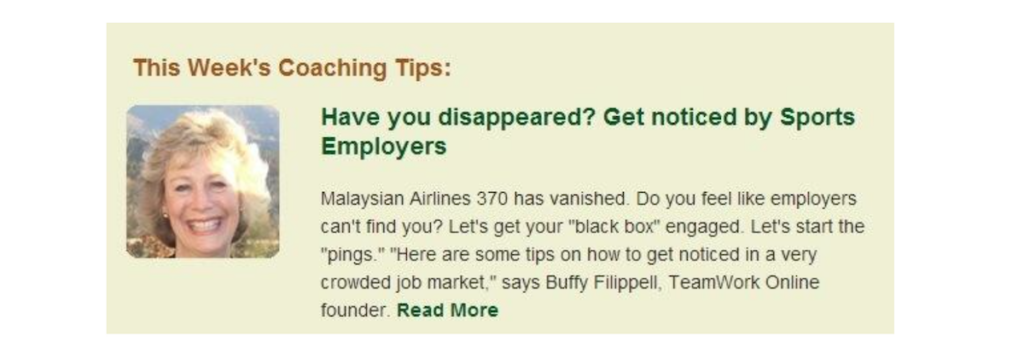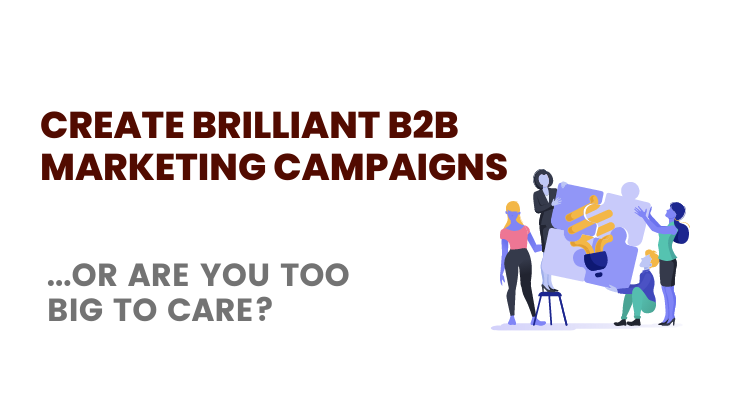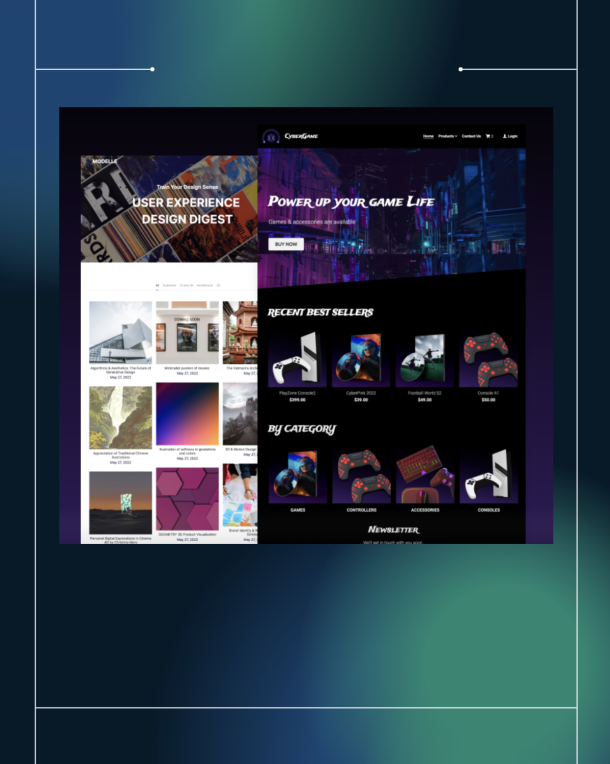B2B marketing is boring. The rallying call to bring out brilliant B2B marketing campaigns now reflects a desperate need.
Where B2C brands (DTC marketing) are colourful, fun, witty, and even exciting; B2B marketing campaigns are boring, filled with jargon, and it all feels even worse than “robotic”.
Enterprise software solution companies, IT technology services, and other large (traditional or not) businesses are all going down that exact same “this is too boring to make an impact, much less bring in revenue”.
Head out to more than half of the websites of any of these businesses, and you’d not even know what they do. A far cry from making you swoon and place an order in bulk.
Is it God complex? Or is it “We are too big to bother?
Search for the “Best marketing campaigns” or “The best marketing campaigns in history” and you’ll rarely (lucky, if you do) see a B2B establishment making the ranks.
It’s sad. It doesn’t have to be this way.
I know this for sure: If you don’t make changes to the way you do marketing and bring out some brilliant B2B campaigns loaded with creativity, emotion, human connect, and fun (I dare say!), you’ll only go down in history for one of the lousiest reasons possible for a business.
Alexandra Rynne — Content Strategy Lead at LinkedIn — just published How to Build Creative B2B Campaigns That Stand Out in which she points out several juicy nuggets of wisdom.
“…writing dry-as-dust white papers and buttoned-down eBooks, it’s time to rejoice and break free. B2B marketing is in the early stages of a creative renaissance, driven by audience demand and fueled by data.”
It’s that creative renaissance that I want to talk about a bit.
Terrible B2B Campaigns: Avoid These, Please!
B2B marketing campaigns sound like robots talk to robots. Campaigns don’t talk to people at all.
Forget brilliant B2B campaigns, passable campaigns, or even B2B campaigns that didn’t work; let’s just talk about the downright embarrassing nonsense that’s the stable for some terrible B2B campaigns in the history of mankind.
Thanks to the folks at Protocol80 who found a few examples of terrible B2B campaigns ever:
According to a press release, here’s that Quantum Tech came up with:

Here’s another one by Teamwork Online

What can you do to change this as a B2B business?
Bank on Compelling B2B Marketing Strategy
Effective content marketing strategy is the kind of stuff that brings in leads, sales revenue, and ultimately profits.
That’s all that matters.
I could care less if your team has Harvard or Princeton graduates working the midnight oil away to come up with insipid and boring content (calling it marketing strategy or content strategy or Inbound nonsense).
According to LinkedIn Research,
More than 30% of thought leadership is considered mediocre (or worse).
About 48% of B2B purchase decision-makers find B2B advertising boring.
71% of B2B ads are likely to generate no sales.
The blog posts you publish aren’t getting the results (no views, shares, and likes are not results). You barely have any social presence. Your CEO, CMO, and CFO (along with the list of your employees) are not on LinkedIn at least.
No thought leadership; no impact.
No one heard a squeak. Ever.
Your ads don’t make money, your content won’t make someone else bat an eyelid (if found), and you have nothing to show for thousands of dollars you pour down the drain.
It’s time to change that. Or we all know where you are headed.
Put people On Spotlight
Take a look at most B2B businesses with some sort of content strategy on. What do you see?
Mostly some content on blogs and on LinkedIn publishing (with the CMO or the CXO taking the lead with thought leadership). What happened to the rest of the employees in the building?
Why can’t they share that post? Why not have conversations going on around that topic?
Need an example of how it’s done?
Semrush sells its products to individual marketers, bloggers, and content creators. But a majority of Semrush sales revenue comes from agencies and other businesses (of all sizes).
Clearly, there’s a B2B side to Semrush.
But see how they communicate? Semrush makes it easy to understand why you should use their product. Semrush also practices what it preaches: with effective content marketing (blogging the right way, and with a publishing cadence), hugely successful webinars, a YouTube Channel.
More importantly, Semrush puts its people first: Real folks (industry experts, professionals, customers, and users) who talk about Semrush, write about Semrush, and more.
Take a look at how brands win with webinars (essentially, most of these businesses listed have a B2B side to them along with a DTC side).
See how Semrush does marketing campaigns, how they do webinars, and how they do live streams.
Note: There are at least 22+ examples of companies and brands that did well (over the years) with a content strategy, thought leadership, build a tight community, and prosper.
That’s how you establish thought leadership.
Publish Consistently
See how LinkedIn (very much a B2B business) publishes on several blogs. On top of that LinkedIn has its own employees publishing individually (like Alexandra, Tequia Burt, and so many others.
Most of what’s published on LinkedIn Collective is done by employees, LinkedIn influencers, professionals in the Industry, and more).
I don’t see B2B businesses publish much (I know, since I work with some)
If they do publish, they don’t do it often. There’s no publishing strategy in place, there’s no publishing velocity, and no character so to speak.
B2B businesses don’t have the same publishing cadence of a few individual bloggers (how shameful is that?).
Change it.
Make it easy to understand (for everyone)
Your potential client (another B2B business) is still run by people. CXO’s PA (personal assistant) could be looking for the right tools for sales prospecting for the entire company. Or a newly-hired marketing manager might be looking for the best product suite for SEO.
Or the web development team just ran out of options for landing pages that can scale with the ever-growing need for creating landing pages for needs such as a geographically-diverse market, numerous landing pages required for various campaigns, and so on.
You don’t know who’s looking for the products and solutions your B2B business provides.
That’s why, you make it easier for everyone to understand:
- Create content, like you speak to your grandmother
- Avoid Jargon (see below)
- Calibrate “informing Vs Selling”.
Change the way you communicate
Most B2B businesses are guilty of using boring, “corporate” type language (everywhere) –websites, brochures (still using those?), emails, ads, and landing pages.
Boring doesn’t even do justice to the way most B2B businesses communicate. Collectively, as teams, there’s a need to move away from “God complex speak” and get down from the high horse.
Speak like normal people do. Write like most of us write.
But this is not going to happen with one or two daredevil marketers trying to push the wagon (people like me are often ignored). It takes a collective push. A resonating and rallying cry for change.
Why change? It brings in more money, silly!
Skip the Jargon
B2B businesses automatically assume that their potential buyers are intelligent, smart, and that they know what they are buying. Thanks to that assumption, the language used is peppered with so much Jargon that you’d puke.
Consider this: let’s say a B2B business wants to invest in computing solutions.
See what Lenovo does below:
Maybe you’ll find it hard to read in the screenshot.
So, here it goes:
“The ThinkStation P620: the world’s first AMD Ryzen™ Threadripper™ PRO workstation. This powerhouse boasts up to 64 cores and 4.0GHz. What’s more, it’s the first workstation to offer PCIe Gen 4 for increased storage speed and expandable memory, as well as unmatched NVIDIA® Quadro® RTX graphics support, and 10GB of built-in ethernet—a new standard in connectivity.”
I am assuming you are Jeff Bezos, buying enterprise versions of these workstations from Lenovo for all Amazon offices scattered worldwide.
Tell me, Mr. Bezos, do you understand a word of what was said?
Fire the extra chef
Part of the reason why B2B marketing gets complicated is because of way too many people working on campaigns. Sadly, most of these people who get hired to do marketing are fresh college graduates who just sank entire volumes of Phillip Kotler’s marketing books.
3 case studies, a few presentations, and a few tests later, they are good to go.
On top of that, their marketing manager is from the same group of MBA-type professionals — this goes all the way to the top: Hello, CMO!
[Good. So why did they forget case studies on Southwest Airlines, Avis Rental, and other awesome brands then?]
Most people don’t realize that the world has changed. They do what they were trained to do. Which is “boring gobbledygook” that pays out in marketing campaigns.
Show Your Human Side
B2B marketing is challenging. Part of the reason is because they brought this on themselves.
Blame the CXO cabals, the marketers, or the whole system. There are ways you can do some excellent marketing for boring industries as well.
How challenging is B2B business marketing, you ask?
Tequia Burt — Editor In Chief, LinkedIn Ads Blog — published an article on building memorable B2B Brands
“B2B companies haven’t invested in building their brands”
She points out that B2B businesses typically rely on “lead generation”.
According to the B2B Institute , more than 80% of B2B marketing budgets are laser-focused on performance marketing (or lead generation).
All that money is spent trying to get people through the doors: those cold-as-ice whitepapers and “booking demo calls”.
But not generating memories. Losing out on the human connection. Lacking in tapping into the power of emotion.
Brand building, as she puts it, suffers.
Creativity Boosts Bottom Line
Creative drives sales. Triggering emotions with creativity? Even better.
In fact, engaged ads that trigger emotions and bring in the human element lead to 10 to 20X more sales, according to Research Gate.
LinkedIn’s custom Internal Data (Jan to Jun’ 2022) reveals that brands with higher emotional engagement acquired 198X more followers (than other peer companies).
Elicit emotion and you get to see upto 44% higher average click-through rate.
Take a Leaf Out of DTC Marketing Style
You already love several DTC brands. You might just as well be an evangelist for some.
There’s Apple with its “Best [insert something like iPhone] Yet” or Nike’s “Just do It”.
MBA students even have games around these taglines.
Heck, a brand name will flash if I just dropped a product category: Smartphones, Smartwatches, Network Attached Storage, Gaming laptops, burgers, and boots.
Do B2B businesses have any such luck? Not so much.
At least not the way DTC brands rule our hearts.
Take a leaf (or run with the whole darned tree) out of DTC campaigns and DTC brands and you’ll get the creative base to make some of the most brilliant B2B campaigns ever.
Take B2B email marketing (one channel, among others). Here’s a quick view of what Nike does with its email marketing campaigns.
Use B2B Marketing Tools at your Disposal
From websites to landing pages; from social media to SEO; from creating ads to CRM solutions — everything is available.
Consider LinkedIn — the all-too-important social platform for business owners, professionals, and even CXOs worldwide. With more than 830+ million users (who mean business), it’s the place every B2B business must be on.
Your LinkedIn account — also allows you to publish LinkedIn Posts (actual posts, long-form writing).
Are you doing it consistently enough as a CXO, editor, marketer?
LinkedIn Ads (Including LinkedIn InMail and LinkedIn Sponsored Messaging, LinkedIn Sponsored Ads, LinkedIn Dynamic Ads, and LinkedIn text Ads)
Are you using these to target specific audiences with ads (bring in the emotion, remember?) and generate results?
Premium LinkedIn accounts (especially LinkedIn Sales Navigator) allow you to tap into the power of social selling. Are you using it effectively enough?
LinkedIn also has audio events, live streams, and LinkedIn groups. If you wanted to, you could use all of these tools for a targeted, focused, and well-managed B2B marketing strategy.
What lessons can you pick from those campaigns as a B2B business trying out email marketing?
The Ingredients for brilliant B2B marketing campaigns are just the same as they’d be for B2C marketing campaigns.
The only issue: B2B businesses forget that they are dealing with humans on the other side.
It’s time to take the massive advantage that marketers and businesses have today — with all of the tools at your disposal — to bring in the change.
Push boundaries. Slay boredom.
Go human again.
Tell me how you work to change your B2B marketing strategy. How are you going to make B2B marketing more human, and effective? When are you rolling out your brilliant B2B campaigns?
Join the conversation on Twitter, on LinkedIn, or share your insights on my LinkedIn page.


